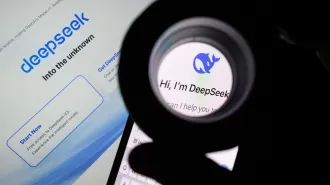Andrei V. Rode didn’t flinch recently when enough power to run 2,000 homes blasted his fingertip. Although staccato bursts of laser light vaporized tiny dots of his flesh, he kept his finger in harm’s way. Rode, a physicist at Australian National University in Canberra, was testing something he’d been told: That the lasers he works with blast materials in such a novel way that they can evaporate his tissue without any pain.





As the cut in his finger deepened and he felt no discomfort, Rode became convinced. When the blood started to flow, he yanked his finger away. His experiment had given him a first-hand experience of a remarkable physical process that physicists first stumbled upon several years ago.
At that time, scientists had just developed the means of creating light pulses of unprecedented brevity but enormous power. They had also found that, by a never-before-seen interaction between light and matter, those pulses were damaging the very laser setups that produced them. The hallmark of this activity was the total annihilation of a chunk of matter with virtually no effect on the material surrounding it.
Investigators found that holes made by the speedy lasers looked preternaturally round. Likewise, where the beams made cuts through a material such as aluminum, the edges looked oddly untouched, with no slag, burrs, cracks, or other signs that something had blasted out the atoms just nanometers away.
Although lasers had long been used for machining, none had ever worked materials so cleanly or with such finesse. “The physics of the process is dramatically different,” says Michael D. Perry of General Atomics in San Diego.
Laser researchers quickly realized that one of the most powerful and precise devices ever invented for sculpting materials might be in their hands. At once both delicate and brutal, the pulses can bore holes as small as a few hundred nanometers across. Ultrafast beams “slice through diamond like butter,” Perry says. Yet biomedical specialists can also use them as super-accurate scalpels for vision-correcting operations–and even for pinpoint surgery on individual cells.
Beam me up . . . and away
Physicists have studied how lasers damage surfaces since the 1960s. When a laser pulse strikes, the rippling electric and magnetic fields of its light waves shake any unattached electrons back and forth (SN: 1/22/00, p. 55: Available to subscribers at Lasers act on cue in electron billiards). Ordinarily, those electrons bump into nearby atoms and pass their energy to them as heat, which on a microscopic scale is the mechanical vibration of atoms. This heat can vaporize the material that the laser beam hits.
However, a pulse lasting 10-trillionths of a second or more, which is long by laser standards, can have a more widespread effect. The sudden, thermal expansion of the irradiated material can launch a damaging shock wave into the surroundings.
That’s not all. Excess heat also surges beyond the irradiated region, and it singes, melts, or otherwise alters material on the perimeter.
By the mid 1990s, scientists were building powerful lasers whose pulses were measured not in billionths or even trillionths of seconds but in thousandths of trillionths of seconds, or femtoseconds. Such time ticks are astoundingly brief. In one second, there are more femtoseconds than there have been hours since the universe began roughly 14 billion years ago. The new lasers became variously known as ultrashort-pulse lasers, ultrafast lasers, or simply as femtosecond lasers.
In the lingo of physics, a device’s power is greater the quicker it transfers energy. So, even a bench-top laser that delivers only enough energy per short pulse to excite a few water molecules can still be astonishingly powerful.
Because their pulses are so brief, some of the new, femtosecond lasers are rated equal–for a fleeting instant–to all the world’s power plants put together.
When scientists looked at the damage caused by such pulses, they saw surprisingly clean, crisp cuts and holes–unlike anything they’d previously observed in laser interactions with matter.
What was happening, they realized, was that electrons energized by the pulse were knocking other electrons loose, and those, in turn, were quickly freeing up yet more electrons. However, this cascade of electron release was taking place too fast for the electrons to transfer their energy to atoms as heat.
Next, because the newly freed electrons electrically repelled each other, they exploded away from the surface. In turn, that outsurge of negative particles pulled along, by electrostatic attraction, the positively charged ionized atoms that had been created by the cascade of electron liberation.
Before heat or shock waves could propagate into the surroundings, the laser-blasted material had vanished.
Precision work
Since the discovery of this novel destructive process, researchers have rushed to take advantage of it. Automakers and heavy-equipment manufacturers, for instance, are investigating the lasers’ use as tools for drilling better fuel injectors for engines. However, a veil of secrecy shrouds that and many other works in progress. “A lot of that stuff just isn’t talked about,” notes femtosecond-laser scientist Peter P. Pronko of the University of Michigan in Ann Arbor.
A notable exception is a system built and used by IBM. Ultrashort-pulse laser processing now serves a vital function in the manufacture of every microchip that the electronics giant sells.
At one stage in the complex microcircuit-production process, chipmakers project light through stencil-like masks to create microscopic patterns in a light-sensitive coating on the chip. The finer the detail in those mask patterns, which are printed in chromium on thin plates of glass, the more electronic components can be crammed onto a tiny fleck of silicon.
Richard A. Haight, Peter Longo, and Alfred Wagner of IBM’s Watson Research Center in Yorktown Heights, N.Y. have developed a femtosecond-laser-based system that knocks out mask-destroying spots of misplaced chromium. Earlier systems that used nanosecond lasers to clean up those spots sometimes spattered chromium onto other parts of the mask or pitted its glass. “The problem was you could cause more defects than you were correcting,” Haight says.
The new mask-repair system focuses its laser to a finer spot size than an earlier version did and therefore can make more precise corrections. In use since the beginning of the year, the device corrects defects in virtually all the photomasks IBM makes–thousands per year. Haight described the device at the Optical Society of America meeting in Orlando, Fla., on Oct. 2.
Because cutting by femtosecond lasers propagates almost no heat, the beams can safely slice through most high explosives, researchers at Lawrence Livermore (Calif.) National Laboratory have found. Longer-pulse lasers ignite the materials. Livermore’s Frank Roeske says that femtosecond lasers have promise as a cold process for dismantling retired rockets, artillery shells, and other weapons.
Besides leaving adjoining material structurally intact, femtosecond-laser pulses don’t provoke chemical changes. This noninvasive aspect of femtosecond lasers may lead to an improved type of stent, a medical device that holds open plaque-choked arteries (SN: 11/24/01, p. 328: Available to subscribers at Things Just Mesh).
Biodegradable stents can prevent the now common problem of arteries renarrowing some time after an operation that unclogs them. However, mechanical tools are too rough to cut stents from delicate biodegradable polymer tubes, and long-pulse lasers melt or spoil the biocompatibility of the material. New experiments show that femtosecond lasers can slice through the fragile polymer without altering its critical biochemical properties, Thorsten Bauer of Laser Zentrum Hannover (LZH) in Germany and his colleagues reported at the Photonics West-LASE 2002 meeting in San Jose, Calif., last January.
An even lighter touch is evident in recent work that demonstrates the femtosecond laser’s potential for gene therapy. In the July 18 Nature, Uday K. Tirlapur and Karsten König of Friedrich Schiller University in Jena, Germany, described vaporizing tiny spots in the membranes of rodent cells immersed in a solution containing the gene for a fluorescent protein.
The cells quickly repaired the holes–but not before the genes had apparently sneaked in, yielding cells that appeared normal except for their green glow.
Inside job
While the brevity of femtosecond-laser pulses makes them remarkably accurate tools for machining, that’s only half the story. Because of their extraordinary intensities–the high number of photons per second they can concentrate into a small area–the pulses also affect materials that are transparent.
In clear substances such as diamond and corneal tissue, most electrons are locked up in chemical bonds. Unless a photon has enough energy to liberate an electron, the light won’t be absorbed. The lack of free electrons prevents the electron-dependent processes by which lasers heat up or vaporize matter.
However, in a femtosecond-laser pulse, the photons are so densely crammed together that bound electrons are likely to get hit by two or more photons at once. Suddenly, there’s plenty of energy for booting electrons out of atoms, and the material no longer lets the light pass through.
By focusing the beam to a certain depth, laser operators can choose how far inside a transparent material the pulse should penetrate before it exceeds the threshold at which multiphoton ionization kicks in. Then, the process quickly sparks an electron avalanche vaporizing everything within the laser spot. “You can actually machine inside a material and not affect its surface at all,” says Duncan P. Hand of Heriot-Watt University in Edinburgh.
In experiments demonstrating how potent this multiphoton ionization can be, researchers have carved cavities into the diamonds used as the jaws of materials squeezing anvils for high-pressure experiments. Ho-Kwang Mao of the Carnegie Institution of Washington (D.C.) says he aims to insert electronic sensors inside those cavities to improve measurements of the nearby pressurized samples.
Other scientists are developing ways of exploiting multiphoton ionization in fields ranging from telecommunications to ophthalmology. For example, Philippe Bado and his coworkers at the start-up company Translume in Ann Arbor, Mich., have developed a technique for using the femtosecond laser pulses to make optical components for sensors and telecommunications. A prototype machine vaporizes channels within domino-size blocks of glass. Longer pulses would deliver too much energy, cracking the glass, Bado says.
When the vapor resolidifies, the channels have slightly altered optical properties compared to the surrounding glass. Because of that mismatch, the channel becomes a waveguide, conducting light like an optical fiber. Waveguides increasingly carry out important functions in communications networks, such as receiving multiple wavelengths of light in one channel and sending them out along separate paths, Bado says.
In a medical application that requires cutting transparent tissues, femtosecond lasers are finding use in the vision-correcting procedure known as LASIK (SN: 7/19/97, p. 44). In the conventional operation, doctors cut open a flap of tissue at the front of the eye with a scalpel that acts like a carpenter’s plane. Then they use nanosecond-pulsed lasers to smoothly shape the underlying corneal tissue.
By making that first cut instead with a femtosecond laser, surgeons can both make a more accurately shaped flap and also reduce the chance of certain post-surgical complications, says Ronald M. Kurtz of the University of California, Irvine. Those complications include tissue abrasions and excessively thin flaps that wrinkle up.
To make the slice, the femtosecond laser points directly into the patient’s eye and moves in a spiral pattern. During that motion, it blasts thousands of tiny spherical cavities in the cornea, all along the same plane. Perforated by the many bubbles, the clear flesh separates at that plane and can be folded back.
In the past year, Intralase of Irvine, Calif., a company cofounded by Kurtz, has sold about 40 femtolaser systems to clinics nationwide. They have used the devices to perform more than 20,000 procedures, Kurtz says.
Eventually, femtosecond lasers may be used for all phases of LASIK surgery, says LZH’s Holger Lubatschowski. He and his colleagues, working with the company Carl Zeiss Meditec of Jena, Germany, have developed a system that fires shorter, less energetic pulses along a novel cutting trajectory. By creating smaller bubbles, the new system makes such smooth slices that it could both cut the flap and shape the underlying cornea, Lubatschowski claims. The researchers plan to start clinical studies early next year.
Hard future
Femtosecond lasers are delicate enough for eye surgery because their high-power, but low-energy pulses only take little nips of materials. For instance, when Rode did his finger-blasting experiment, the laser firing a thousand times per second took nearly 30 seconds to draw blood. For machining harder materials, today’s femtosecond lasers are even slower.
For example, in a recent study of the lasers’ potential for dentistry, Rode and his colleagues found that ultrafast pulses could remove bits of tooth without affecting surrounding material. The researchers expect ultrafast-laser dentistry to be painless and protect nearby healthy enamel.
However, the removal rate has to speed up by a factor of 100 or so for the lasers to compete with mechanical drills, Rode says. The team reported its findings in the Aug. 15 Journal of Applied Physics.
Laser specialists say that other promising uses of femtosecond lasers, such as drilling fuel-injector nozzles in steel, are being held back because today’s lasers are too slow and too costly. However, laser makers report that they’re developing even better designs that may soon make it possible to boost the pulse rate 100- to 1,000-fold and to make simpler, more reliable units. “In the near future, these systems will be getting much smaller and less expensive,” Lubatschowski predicts.
Once that happens, many more items in the world–from teeth to car engines–are going to get blasted into better shape, tiny bit by tiny bit.
****************
If you have a comment on this article that you would like considered for publication in Science News, please send it to editors@sciencenews.org.
To subscribe to Science News (print), go to https://www.kable.com/pub/scnw/subServices.asp.
To sign up for the free weekly e-LETTER from Science News, go to http://www.sciencenews.org/subscribe_form.asp.





